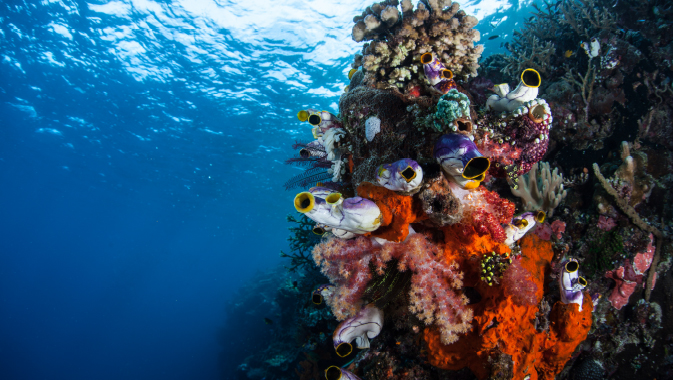Deliberately or accidentally dumped into the world’s oceans, pollutants like plastic, oil, fertilizers, pesticides, and raw sewage are responsible for declining water quality, reduced biodiversity, and dwindling marine life.
Every day, the world’s rivers, lakes, seas, and oceans take a beating.
From disasters like the Deepwater Horizon spill of a decade ago – the biggest oil spill in the history of the industry, spewing over 200 million gallons into the Gulf of Mexico over 87 days – to billions of plastic bottles, bags, and bits of packaging clogging waterways, the planet is struggling. And far from just being an issue confined to developing nations, pollution aggressively impacts Canada and the United States, where cities from Montreal to Vancouver continue dumping millions of litres of untreated sewage directly into lakes and rivers.
Making pollution even worse are accidental waste spills like the one last July at Seattle’s West Point Treatment Plant. Backup pumps, instead of kicking in during a power outage, failed to work, resulting in about three million gallons of raw sewage flooding Puget Sound. Although the untreated waste flowed for only 30 minutes, the contamination was enough to close several beaches for days.
The unthinkable
As inconceivable as it seems, some large companies have been caught knowingly and wilfully polluting oceans. Back in 2016, Princess Cruise Lines agreed to pay a staggering $40 million penalty – “the largest-ever criminal penalty involving deliberate vessel pollution” according to the United States Department of Justice – for illegally dumping contaminated oil from its Caribbean Princess cruise ship.
The vessel, which visited ports in Florida, Puerto Rico and other places, used a so-called ‘magic pipe’ to illegally dump “oily waste off the coast of England.” Even more appalling was the revelation in court documents that the same cruise ship was making “illegal discharges” going back to 2005.
The damning 92-page Plea Agreement (United States of America v. Princess Cruise Lines, Ltd., Defendant) states reasons for the landmark penalty against the cruise line, ranging from knowingly discharging and disposing oily mixtures, “including oily bilge water and slops from bilges,” to making false entries in the Caribbean Princess’s Oil Record Book and failing to maintain discharge records.
Most appalling of all is that the ship’s Chief Engineer and Senior First Engineer knowingly made the discharge, involving several subordinate crew members in this before an unnamed whistleblower took photos and videos of the ‘magic’ bypass pipe used for illegal discharge.
When the decision was handed down, U.S. Attorney Wifredo A. Ferrer stated that the $40-million penalty sent a strong message to all companies about the need to protect the environment, saying that “the U.S. government will continue to enforce a zero tolerance policy for deliberate ocean dumping that endangers the countless animals, marine life and humans who rely on clean water to survive.”
As just one example, the Caribbean Princess reinforced the urgency of the need to protect the world’s oceans. Water covers about 71 percent of the planet’s surface, and oceans are home to at least one million different living species. For everything from adult blue whales weighing up to 300,000 pounds (136,077 kg.) to microscopic phytoplankton providing food, maintaining the health of our oceans is vital to all life on earth.
Protecting the cradle of creation
Despite humankind depending on the world’s oceans as a valuable source of food and commerce for thousands of years, it wasn’t until shortly after the Second World War that the present-day version of marine conservation took hold. Recognizing the tremendous importance oceans hold for the entire chain of living things, the rise of marine protection coincided with new technologies, sparking an increase in resource-sector activities including underwater oil exploration and mining.
Awareness of the need to protect oceans grew throughout the fifties, sixties and seventies with explorers and filmmakers like Jacques-Yves Cousteau and his influential first book, The Silent World: A Story of Undersea Discovery and Adventure. This was soon followed by other landmark books supporting conservation and protection, most notably Rachel Carson’s 1962 Silent Spring. While focusing primarily on the harmful effects of pesticides, Carson’s landmark book triggered a movement leading to the creation of the Environmental Protection Agency (EPA) in the United States in 1970.
Awareness of pollution and the need to protect biodiversity – particularly in designated hot spots – grew sharply in the 1970s and 1980s, and has continued to grow, along with the rise of marine conservation and management organizations, to this day.
Documentaries and books including 2014’s Marine Conservation: Science, Policy and Management, and the Handbook on Marine Environment Protection, published in 2018, have been influential.
Worldwide, many organizations are dedicated to protecting the world’s lakes and oceans, including the Nature Conservancy (one of the oldest, founded in 1951), Greenpeace, the Project AWARE Foundation, Oceana, the Ocean Conservancy, and the Environmental Defence Fund. Perhaps the largest and best-known of all is the World Wildlife Fund (WWF). Operating in 100 countries and with some five million members, the WWF is extremely active in marine protected areas (MPAs). Encompassing not only oceans but Great Lakes, seas and estuaries, MPAs vary in size, and can include wildlife refuges, fully protected marine areas, parks, sanctuaries, and research facilities.
Restoring and replenishing
With so much contingent on the protection of these areas, it’s disappointing that a total area of less than four percent of our oceans is protected.
Defined by the WWF as “an area designated and effectively managed to protect marine ecosystems, processes, habitats, and species which can contribute to the restoration and replenishment of resources for social, economic, and cultural enrichment,” Marine Protected Areas are crucial to safeguarding marine and human life alike, since depleting stocks of fish means less food available in the ocean, and less for humans.
Operating in 14 priority areas globally – from the Gulf of California to the Galapagos, Coastal East Africa, the Southwest Pacific and other areas – the WWF and other organizations acknowledge the many benefits of protecting marine areas, from maintaining local economies and jobs for fishermen to allowing fish to spawn and grow to adulthood in safety.
Worldwide, not only environmental groups but also governments are working hard, ensuring the protection of marine conservation areas, prohibiting mining, oil, and gas companies from operation in select areas.
Old problem, new standards
In April 2019 Canada’s then-Minister of Fisheries, Oceans and the Canadian Coast Guard (now Minister of Environment and Climate Change) Jonathan Wilkinson announced updates to the standards governing marine protected areas. Following the appointment of “an independent National Advisory Panel of experts to consult Canadians about marine protection acts” and cross-Canada consultations, the new standards governing ocean protection were created.
Addressing the need for safeguarding Canada’s oceans, the new recommendations include conservation areas like marine refuges, and high-level marine protected areas. Following recommendations of the National Advisory Panel on Marine Protected Area Standards, four industrial activities in these areas were prohibited: “oil and gas activities, mining, dumping, and bottom trawling.”
Widely covered in the media, the dramatic marine protection changes drew praise from the public, politicians, and environmental groups alike across the nation, including the WWF and Oceana Canada.
Founded in 2001, the Toronto-headquartered independent charity Oceana Canada is part of the international organization Oceana, dedicated entirely to the preservation and conservation of the oceans and everything that inhabits them. For Canada, the sweeping changes brought in to safeguard some of the nation’s 2.76 million square kilometres of ocean by deeming them MPAs – and so free from mining, and oil and gas recovery – was viewed as a major step towards the future well-being of Canada’s waters.
“Canada is an oceans country,” said Catherine McKenna, Minister of Environment and Climate Change at the time. “We are the stewards of the longest coastline in the world. Protecting Canada’s nature and the health of our oceans benefits our communities, our ecosystems, and our wildlife.”
Assessment and urgency
One of the biggest initiatives towards protecting the planet in recent years is the World Ocean Assessment (WOA). Released in 2015, the first WOA was created under the UN Environment Programme. Reporting on the state of our oceans, the WOA involved over 600 scientists in the report, addressing 10 themes including the increasing inputs of harmful material; food security and food safety; and the cumulative effects of human activities on marine biodiversity.
Examining multiple areas, including environmental, social, and economic implications, the findings of the report are dire. “The findings indicate that the oceans’ carrying capacity (their ability to sustain human activities and their impacts) is near or at its limit and urgent action on a global scale is needed to protect what remains.”
Oceans are one of our biggest sources of biodiversity, and represent life itself. Without healthy oceans, the planet would cease to exist. But with increased environmental awareness, stricter laws and penalties for reckless dumping, and a growing sense of urgency, it is possible that we will see the health of oceans restored in our lifetimes.






